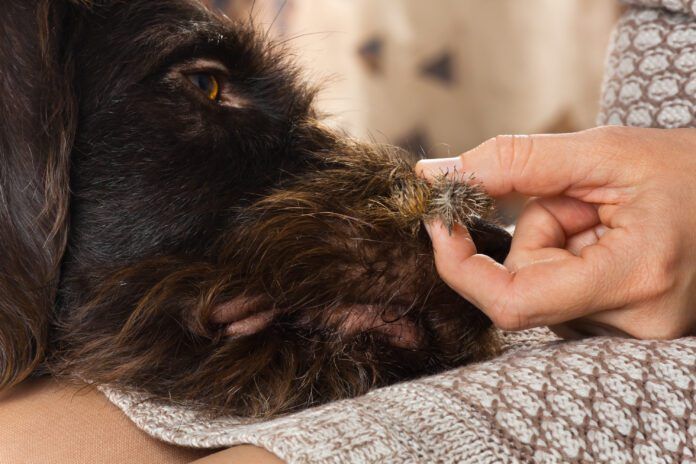If you live where plants produce spikey seeds that cling to a dog’s hair, you’ve probably encountered burrs. These seed or fruit pods with tiny barbs, hooks, or sharp spines can be difficult to remove, but the right equipment will simplify the task.
What Are Burrs?
Burrs are seeds that attach to clothing, fur, or feathers and help disperse seeds over a wide area. Cockleburs (Xanthium species) and burdock (Arctium species) are common examples. Annoying to pets and hikers, burrs are difficult to remove without tearing hair or fabric, and at their worst they can injure the skin and damage canine coats.
Burrs are different from awns, which are bristle-like extensions attached to the seeds or flowers of grains and grasses. Sharp or barbed awns such as foxtail grasses (Setaria or Hordeium species) can painfully puncture an animal’s fur, feet, or skin. Awns are dangerous because they can burrow into ears, eyes, and noses, requiring medical attention. The same treatments that remove burrs can help keep your dog from attracting awns.
Before attempting to remove burrs, take a close look at your dog’s coat. Burrs can accumulate anywhere, especially on a long- or thick-haired dog, but they’re often found in and around the ears, paws, armpits, tail, and abdomen. Burrs are not always visible, so feel gently all over your dog’s coat.
Some dogs rarely pick up burrs while others are burr magnets. Burrs don’t tend to collect on short-haired dogs, while breeds with long, dense, or curly coats are more likely to get burrs tangled in their hair.
Groomers’ Recommendations for Removing Burrs from Dogs
Montana pet groomer Angie Anderson has years of experience with burr-collecting Brittany Spaniels, Springer Spaniels, and Setters. “A lot of our field dogs tend to attract burrs,” she says.
The fastest and safest way to remove burrs, according to Anderson, is to treat them with a detangling grooming product such as a silicone spray. “My favorite is Cowboy Magic,” she says. “It’s a horse-grooming product for manes and tails, but it’s safe for dogs, too. Spraying it onto a burr, even one that’s badly tangled in your dog’s hair, makes the burr easy to remove with a comb or your fingers.”
Grooming educator Barbara Bird agrees, saying, “Silicone is a wildly effective and useful ingredient found in many pet care products but one that is often misunderstood. Some brands advertise that they contain ‘no silicone’ as if that were a bonus. Rumor has it that silicone builds up on hair and damages it by causing yellowing and breakage. This may have been true of early silicone-based products, but times have changed.
Unlike the silicones of yesteryear, modern products don’t build up in the hair.” Bird’s favorite silicone detangler for dogs is Maxx Best Shot Detangler & Conditioner.
Those who prefer more natural-sounding ingredients will find them in Skout’s Honor Probiotic Pet Detangler, which contains beneficial bacteria, fermented figs and lemons, coconut or avocado oils, and omega fatty acids, or in Hoof & Paw’s Natural Detangling Spray, which contains aloe vera, argan oil, vegetable glycerin, vinegar, silk peptides, and guar gum. “These products will work,” says Anderson, “but in general, burrs are more difficult to remove with products that don’t contain silicone.”
How to Get Burrs Out of Dog Hair Without a Detangler
For those who don’t have a detangling product handy and who have a burr-covered dog, most experts recommend assembling these do-it-yourself tools:
- A wide-toothed metal comb
- A fine-toothed comb, flea comb, or hair pick
- A brush to use as a final step
- Tweezers or a pin or needle to help loosen burr-entangled hair
- A pair of pilers to crush hard-to-remove burrs
- Coconut oil or a similar edible vegetable oil
- Towels, paper towels, or absorbent fabric to help with cleanup
- Gloves, such as flexible gardening gloves, to protect your hands
- Treats
Burrs that adhere to the surface of your dog’s coat may be easy to remove with your fingers. Untangle a burr gently to release it without pulling your dog’s hair. If desired, wear flexible gloves to help prevent your fingers from being pricked by sharp points.
Coconut and other vegetable oils help release snarls and tangles, so if your dog has picked up several burrs, apply the oil directly to and around the burrs and let it saturate the area. “The down side of edible oils is that they can stain truck seats, furniture, and clothing, so cleaning your dog’s coat after the burrs are gone is a good idea,” says Anderson.
If the burr is tightly tangled, use tweezers, a pin, or a sewing needle to gently pull hair from burr tangles, then use a wide-toothed metal dog comb or hair pick to gently lift a loosely attached burr by working your comb under the burr.
If necessary, crush a burr with pliers to break it into smaller pieces, which will be easier to remove.
After removing visible burrs, feel gently all over your dog’s coat to check for burrs hidden under the hair’s surface. Then thoroughly brush your dog’s coat.
“Sometimes a dog picks up so many burrs that the project seems overwhelming,” says Anderson. “In that case, a trip to a groomer can solve the problem. Experienced groomers often find that a burr infestation is far less serious than the owner assumes. Cutting burrs from your dog’s coat with scissors is not recommended. It’s definitely worth checking with a groomer if you’re not able to easily remove your dog’s burrs.”
Keep Treats Handy for Easier Burr Removal
You’ll need your dog’s cooperation to remove burrs because if he or she pulls, runs away, or refuses to hold still, the project can be painful, lengthy, and unpleasant for both of you. Skip boring treats like routine kibble and offer high-reward treats that will seriously distract and reward your dog. It may help to have another human on hand to keep your dog calm while you remove burrs.
Tips for Preventing Burr Problems
Regular brushing will help your dog avoid burrs, especially if your dog has a long or thick coat. Brushing can remove hair that your dog is about to shed, which streamlines a coat that would otherwise attract burrs.
Learn to recognize plants and bushes that contain burrs and avoid them or put your dog in a protective coat for walks. When you get home, check your dog’s hair, especially between toes, behind ears, in armpits, around the tail, and under the belly.
Angie Anderson recommends having a dog professionally groomed before leaving on hunting or camping trips or vacations that will expose your dog to burrs. “This means trimming the belly and leg hair to reduce exposure,” she explains. “I also recommend spraying the coat with a silicone spray or leave-in conditioner, then brushing it through the coat before you go out into the field. If you do that, your dog is unlikely to pick up any burrs at all. If burrs do show up, they’ll comb right out, or if they don’t, simply dampen the burrs with conditioner and let it sit for a while.”






